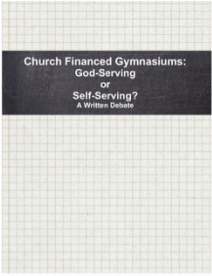
By: Marcus Reppert
The book begins with the article written by Bro. Grizzell in Contenting For The Faith in which he argues against church financed gymnasiums. Grizzell contends that there is no biblical authority for the church to use treasury funds to build gymnasiums, which are primarily used for entertainment and recreation purposes. He explains that treasury funds collected by each local congregation are to be used for the scriptural work of the church, including edification, benevolence, and evangelism. Grizzell stresses time and again that it is the duty of the home (parents) to provide entertainment and recreational opportunities for their children.
Bro. Brite’s first letter criticizes Bro. Grizzell’s article and the journal Contending for the Faith.
He labels Grizzell an “anti” and that he is inconsistent in opposing church financed gymnasiums, or “multi-purpose facilities” as he calls them throughout the exchange, while approving church kitchens, bathrooms, and water fountains. Brite argues that a “multi-purpose facility” is a better use of funds because it can be used multiple days throughout the week (besides just Sunday and Wednesday) for fellowship, recreation and worship as opposed to a “traditional building” that can only be used for worship. He asks Grizzell if he (Brite) is going to hell for worshipping in a gymnasium and concludes his first letter by implying that Contending For The Faith and its followers are “continuing to drift further and further into the sea of legalism”.
Following this initial discussion, each brother responds to the other until four letters in all are exchanged. Grizzell repeatedly asks for scriptural evidence to defend the building of gymnasiums using church funds and Brite cannot legitimately answer him. Grizzell’s letters become increasingly specific and lengthy as he attempts to pin Brite down on specific points and Brite’s responses grow less detailed and briefer as he struggles to defend his assertions. His final letter is little more than a repeat of the same points he has made throughout the debate.
This book is an easy read and will make a great resource for anyone regarding the subjects of the work of the church and the scriptural use of the treasury. These controversial issues are not going away especially when many in our brotherhood are taking a liberal view of the scriptural use of the treasury. The book is a rare resource on this specific issue, but one that we must be prepared to face. I recommend this book to all who want to be ready to “give a defense to everyone who asks you a reason for the hope that is in you, with meekness and fear” (I Pet. 3:15) concerning this subject.

 RSS Feed
RSS Feed
